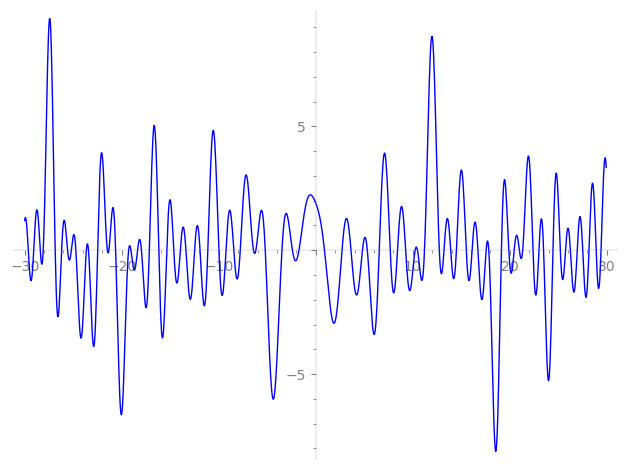| L(s) = 1 | + (0.631 − 1.61i)3-s + (1.81 + 1.05i)5-s + 3.85i·7-s + (−2.20 − 2.03i)9-s − 2.41·11-s + (2.57 + 4.45i)13-s + (2.84 − 2.27i)15-s + (2.36 + 1.36i)17-s + (−1.37 + 4.13i)19-s + (6.22 + 2.43i)21-s + (2.33 + 4.05i)23-s + (−0.293 − 0.508i)25-s + (−4.67 + 2.26i)27-s + (6.26 − 3.61i)29-s − 2.26i·31-s + ⋯ |
| L(s) = 1 | + (0.364 − 0.931i)3-s + (0.813 + 0.469i)5-s + 1.45i·7-s + (−0.733 − 0.679i)9-s − 0.729·11-s + (0.713 + 1.23i)13-s + (0.734 − 0.586i)15-s + (0.573 + 0.330i)17-s + (−0.316 + 0.948i)19-s + (1.35 + 0.531i)21-s + (0.487 + 0.844i)23-s + (−0.0586 − 0.101i)25-s + (−0.900 + 0.435i)27-s + (1.16 − 0.671i)29-s − 0.406i·31-s + ⋯ |
Λ(s)=(=(912s/2ΓC(s)L(s)(0.844−0.535i)Λ(2−s)
Λ(s)=(=(912s/2ΓC(s+1/2)L(s)(0.844−0.535i)Λ(1−s)
| Degree: |
2 |
| Conductor: |
912
= 24⋅3⋅19
|
| Sign: |
0.844−0.535i
|
| Analytic conductor: |
7.28235 |
| Root analytic conductor: |
2.69858 |
| Motivic weight: |
1 |
| Rational: |
no |
| Arithmetic: |
yes |
| Character: |
χ912(239,⋅)
|
| Primitive: |
yes
|
| Self-dual: |
no
|
| Analytic rank: |
0
|
| Selberg data: |
(2, 912, ( :1/2), 0.844−0.535i)
|
Particular Values
| L(1) |
≈ |
1.83515+0.532347i |
| L(21) |
≈ |
1.83515+0.532347i |
| L(23) |
|
not available |
| L(1) |
|
not available |
L(s)=p∏Fp(p−s)−1 | p | Fp(T) |
|---|
| bad | 2 | 1 |
| 3 | 1+(−0.631+1.61i)T |
| 19 | 1+(1.37−4.13i)T |
| good | 5 | 1+(−1.81−1.05i)T+(2.5+4.33i)T2 |
| 7 | 1−3.85iT−7T2 |
| 11 | 1+2.41T+11T2 |
| 13 | 1+(−2.57−4.45i)T+(−6.5+11.2i)T2 |
| 17 | 1+(−2.36−1.36i)T+(8.5+14.7i)T2 |
| 23 | 1+(−2.33−4.05i)T+(−11.5+19.9i)T2 |
| 29 | 1+(−6.26+3.61i)T+(14.5−25.1i)T2 |
| 31 | 1+2.26iT−31T2 |
| 37 | 1+4.73T+37T2 |
| 41 | 1+(−10.1−5.86i)T+(20.5+35.5i)T2 |
| 43 | 1+(8.19+4.72i)T+(21.5+37.2i)T2 |
| 47 | 1+(2.29+3.97i)T+(−23.5+40.7i)T2 |
| 53 | 1+(8.79−5.07i)T+(26.5−45.8i)T2 |
| 59 | 1+(−6.43+11.1i)T+(−29.5−51.0i)T2 |
| 61 | 1+(−1.57−2.72i)T+(−30.5+52.8i)T2 |
| 67 | 1+(−1.92+1.11i)T+(33.5−58.0i)T2 |
| 71 | 1+(−1.29+2.23i)T+(−35.5−61.4i)T2 |
| 73 | 1+(−7.23+12.5i)T+(−36.5−63.2i)T2 |
| 79 | 1+(−5.16−2.98i)T+(39.5+68.4i)T2 |
| 83 | 1−12.8T+83T2 |
| 89 | 1+(−5.45+3.15i)T+(44.5−77.0i)T2 |
| 97 | 1+(1.20−2.08i)T+(−48.5−84.0i)T2 |
| show more | |
| show less | |
L(s)=p∏ j=1∏2(1−αj,pp−s)−1
Imaginary part of the first few zeros on the critical line
−9.978666624413622539417004806204, −9.252009964112354668528392639194, −8.445465733400793853637285784062, −7.77858168298250804772773660574, −6.41652710483290014880959554031, −6.16957499693530239157763090042, −5.20182756969286050854953216662, −3.48299869268092379728809998869, −2.40164757873645051876531743030, −1.72841591694000678797496501180,
0.902794757383563436980618919917, 2.71004367897344253015547950919, 3.63773061413549599718847114449, 4.81637128650680742388697964169, 5.31891738743684823274819227193, 6.54789390874653773624229838341, 7.67837418347895016276004866584, 8.432563830968330833463000119342, 9.271499127860669206285411268566, 10.24923468745172781434992350273

